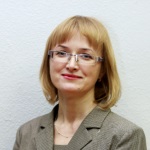
Визначення вмісту гумусу в ґрунтах за матеріалами космічної зйомки – це найбільш детально пророблений в методичному та практичному відношенні розділ дистанційного моніторингу ґрунтів. Воно вже досить широко використовується на практиці та має достовірні результати. При дотриманні технології похибка дистанційного визначення гумусу не більша за похибку лабораторних аналітичних визначень [1].
В чому полягає технологія дистанційного визначення вмісту гумусу?
Припустимо, є знімок поля, вільного від рослинного покриву, поверхня якого візуально неоднорідна за кольором. З певною вірогідністю ця неоднорідність пояснюється різницею в гумусованості ґрунту, яку ми прагнемо кількісно оцінити.
По-перше, треба переконатися, що ця диференціація обумовлена саме забарвленням ґрунту, а не рослинним покривом або рештками рослин.
Для цього необхідно або побудувати нормалізований різницевий вегетаційний індекс (NDVI), або довіритись експертній оцінці. Останню, до речі, здатна провести людина з мінімальним обсягом знань і навичок візуального дешифрування (рис.1).

Рис. 1. Виділити вільні від рослинності поля на кольоровому зображенні неважко
Дещо складніше відокремити повністю відкриті поля від полів з наслідками різноманітних агротехнологічних операцій – проходи техніки, залишки стерні тощо (рис.2).

Рис. 2. Світлі смуги та лінії на цьому полі – не еродованість ґрунту, а рослинні залишки
Для визначення того, чи не є неоднорідність забарвлення непритаманним для даного ґрунтового покриву артефактом, доцільно враховувати як прямі, так і непрямі дешифрувальні ознаки. Наприклад, очевидно, що складна структура ліній світлого тону однакової ширини на рисунку 2 має антропогенний характер і обумовлена рослинними рештками.
Складніша ситуація на рисунку 3. Тут на полі спостерігаються світлі ділянки, що мають різне походження.

Рис. 3. Приклад поля, де неоднорідність забарвлення зумовлена одночасно декількома різними факторами. Цифрами позначені: 1 – прояви водної ерозії ґрунту, 2 – рослинні рештки, що залишились після обробітку ґрунту, 3 – польовий шлях, 4 – частина поля з непереораною стернею
Отже, з представлених трьох знімків, лише на першому строкатість обумовлена саме власним забарвленням ґрунту. Відповідно з цим знімком і можна працювати надалі, інші 2 знімки для визначення вмісту гумусу непридатні.
Космічний знімок є растровим зображенням, кожен піксель якого характеризується певними цифровими значеннями – спектральними яскравостями. Як ми вже знаємо, яскравість, яку ми сприймаємо як тон, або колір знімка, значною мірою обумовлена вмістом гумусу. Отже зрозуміло, що встановивши математичну залежність між спектральною яскравістю (Я) та вмістом гумусу (Н) нескладно перерахувати яскравість в гумус.
Коли знімок потрібної якості підібраний, робота ведеться за простою схемою, яка в 90-ти роки в Україні була розроблена ґрунтознавцями Інституту ґрунтознавства та агрохімії імені О.Н. Соколовського.
Проілюструємо її прикладом з класичного дослідження Анатолія Васильовича Шатохіна, в якому створювалась та відпрацьовувалась методика визначення вмісту гумусу за космічними знімками [2].
Етапи роботи з дистанційного визначення вмісту гумусу в ґрунтах
1) Обирається одне найбільш типове поле, на якому візуально спостерігається значна неоднорідність забарвлення, а отже й перепад значень яскравості знімку та вмісту гумусу.
Важливо! Забарвлення ґрунту сильно залежить від його вологості. Тому для дистанційного визначення вмісту гумусу необхідно обирати поля, поверхня ґрунту яких знаходиться у так званому повітряно-сухому стані. Для цього аналізують архівні дані метеоспостережень та обирають знімки за той період, коли опадів не спостерігалось принаймні три-чотири дні.

Рис. 4. Знімок Дослідних полів ДІАП, що використовувався для відпрацювання методики визначення вмісту гумусу за даними ДЗЗ (діапазон 0,79-0,89 мкм) [2]
В дослідженнях використовувались монохромні знімки отримані супутником SPOT (рис. 4). Основні технічні характеристики сенсору: роздільна здатність – 20 м; діапазони зйомки – 1) 0,50-0,59 мкм, 2) 0,61-0,68 мкм, 3) 0,79-0,89 мкм.
Трикутне поле в центрі знімку площею 146 га вільне від рослинності, тобто неоднорідність забарвлення зображення обумовлена лише властивостями ґрунтового покриву [2].
2) Для одержання рівняння залежності між спектральною яскравістю та вмістом гумусу проводять польові дослідження, під час яких відбирають проби ґрунту з визначенням точних координат точок відбору зразків за допомогою GPS (рис. 5). На даному полі зразки ґрунту були відібрані за регулярною мережею в 129 точках через кожні 100 м.

Рис. 5. Знімок досліджуваного поля в діапазоні 0,79-0,89 мкм (КА SPOT) з накладеною регулярною мережею відбору зразків грунту
3) В подальшому в лабораторних умовах визначають вміст гумусу (Н). Оскільки всі точки відбору зразків мають географічну прив’язку, це дозволяє надалі визначити значення яскравості (Я) для пікселів, які територіально відповідають відібраним ґрунтовим зразкам. Таким чином для кожної з точок відбору отримують 2 кількісних значення – яскравість знімка та вміст гумусу в ґрунті, визначений лабораторним шляхом.
4) За допомогою статистичного аналізу підбирають рівняння залежності між цими показниками, що найбільш повно та достовірно описує залежність, що існує.
В дослідженнях А.В.Шатохіна була проведена оцінка зв’язку вмісту гумусу із яскравістю в трьох спектральних діапазонах, та найбільш тісною виявилась залежність між вмістом гумусу та яскравістю у червоному діапазоні, яку і взяли в подальшому за основу для визначення вмісту гумусу. Найбільш тісний зв’язок вмісту гумусу в ґрунті саме з яскравістю в червоному та ближньому інфрачервоному діапазоні відмічали й інші українські дослідники [1, 3, 4, 5].
Для даного поля залежність яскравості знімка в червоному діапазоні від вмісту гумусу в ґрунті описується таким регресійним рівнянням (рис.6):
Я = 46,7 + exp ( 4,562 – 0,64 * Н )
Коефіцієнт детермінації цього рівняння становить r2 = 0,77, що свідчить про те, що 77% варіабельності яскравості знімку обумовлено саме впливом вмісту гумусу. Враховуючи, що, як ми вже розповідали, спектральна відбивна здатність ґрунту обумовлена не лише тільки гумусом, це досить високий показник тісноти зв’язку.

Рис. 6. Залежність яскравості ґрунту в червоному діапазоні від вмісту в ньому гумусу
5) Відповідно до одержаної формули, розраховують значення вмісту гумусу в кожному пікселі зображення, отримуючи електронну карту гумусованості ґрунтів (рис. 7).

Рис. 7. Електронна карта вмісту гумусу у ґрунтах дослідного поля, створена за супутниковими даними
Яку легко можна перетворити в більшу зручну для сприйняття картограму (рис. 8), обираючи кількість градацій на власний розсуд.

Рис. 8. Картограма вмісту гумусу у ґрунтах дослідного поля, створена з карти гумусованості грунів
6) Залежність яскравості знімка від вмісту гумусу, отримана за даною технологією, може використовуватись як робоче рівняння для розрахунків вмісту гумусу в ґрунтах для ґрунтів близького генезису та гранулометричного складу. Наприклад, вказане рівняння отримане для чорноземів звичайних на лесових породах. Воно придатне для чорноземів звичайних на лесових породах, обмежено придатне для чорноземів типових на лесових породах, та зовсім непридатне для ґрунтів іншого генетичного ряду (наприклад, опідзолених, чи гідроморфних), а також, для ґрунтів, сформованих на інших породах – наприклад пісках, або червоно-бурих глинах.
Отже дистанційне визначення вмісту гумусу у ґрунтах – це вже фактично рутинне завдання, що легко може виконуватись за умов дотримання певних правил:
- Вміст гумусу за даними космічної зйомки потребує попереднього прискіпливого відбирання дійсно відкритих полів, вільних від рослинних решток та інших артефактів.
- Для дистанційного визначення вмісту гумусу необхідно побудувати робоче рівняння статистичної залежності яскравостей знімка від вмісту гумусу, для чого треба обрати одне найбільш типове за ґрунтовим покривом поле, провести на ньому польові дослідження з відбором та подальшим аналізом зразків.
- Отримані статистичні рівняння можна використовувати тільки для тих самих ґрунтів, на тих самих породах та тієї ж зони, для яких вони створені.
З огляду на це, знову згадаємо про дрони – порівняно зі супутниковою зйомкою вони, виявляється, мають ще одну перевагу – не потрібно вишукувати вільне поле, пристосовуючись під обставини та обираючи «краще серед гіршого». Потрібне нам відкрите типове поле, що відповідає всім нашим вимогам, ми можемо спочатку обрати на свій розсуд, а вже потім провести його зйомку в найбільш зручний час, враховуючи погодні умови та відсутність рослинного покриву. Навіть вже після відбору ґрунтових зразків.
Посилання
- Ачасов А.Б. Протиерозійна оптимізація агроландшафтів: геоінформаційний підхід / А.Б. Ачасов; Харк. нац. аграр. ун-т. – Х., 2016. ; 409 с.: іл. – Бібліогр.: с. 366–408. – Деп. у ДНТБ України 09.12.2016, № 15 – РІД/Ук – 2016
- Шатохин А. В. Дистанционное зондирование и геоинформационные технологии при исследовании почвенного покрова / А. В. Шатохин / Третя Українська нарада користувачів аерокосмічної інформації: зб. наук. доп. — К: Знання України, 2001. — С. 48 — 62
- Сахацький, О.І. Досвід використання супутникових даних для оцінки стану ґрунтів з метою розв’язання природо-ресурсних задач / О.І. Сахацький // Доповіді Національної академії наук України. – 2008. – № 3. – С. 109–115.
- Трускавецький, С.Р. Використання багатоспектрального космічного скану- вання та геоінформаційних систем у дослідженні ґрунтовогопо криву Полісся України: автореф. дис. …канд. с.-г. наук: 03.00.18 / С.Р. Трускавецький. – Х., 2006. – 24 с.
- Чорний, С.Г. До питання визначення вмісту гумусу в ґрунтах дистанційними методами / С.Г. Чорний, І.М. Гашпоренко // Вісник аграрної науки Причорномор’я. – 2009. – № 2(49). – С. 163–167





